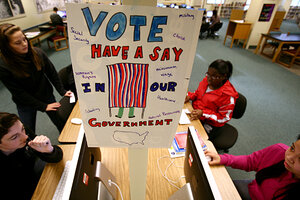A third of high school seniors lack basic grasp of civics, US government
America's students are largely uninformed about the democratic process and US government, especially high school seniors, according to civics scores from the Nation's Report Card.

John Wagner/News-Miner West Valley High School students cast their ballots electronically during Kids Voting USA in this November 2010 file photo. Civic scores indicated relatively poor knowledge in the democratic process and US government by students at all levels, and particularly among seniors, according to a new report.
ZUMA Press/Newscom/File
America’s students have little knowledge about how the democratic process works – including those on the cusp of voting themselves, according to the most recent results from the Nation’s Report Card.
The civics scores released Wednesday by the National Assessment of Educational Progress (NAEP) had a few bright spots – particularly for fourth-graders and for Hispanic students. But overall they indicated relatively poor civics knowledge by students at all levels, and particularly among 12th-graders.
Just 24 percent of high school seniors scored at a proficient level or above, a slight drop from the last civics test in 2006, largely driven by declining scores for 12th-grade girls. Just 4 percent of seniors scored at an advanced level, and 36 percent didn’t even reach the most basic level.
Are you smarter than a 12th-grader? A reading comprehension quiz
“Knowledge of our system of government is not handed down through the gene pool,” said retired Supreme Court Justice Sandra Day O’Connor, speaking at the report’s release. “What these scores tell us is that we’re not doing well enough in educating young people about our government and how it works.”
The test – a mix of multiple-choice and short-answer responses – addresses civics knowledge, intellectual and participatory skills, and civic dispositions, and covers topics that include the foundations of the US political system, the role of citizens in an American democracy, and the relationship of the US to other nations.
"The NAEP results confirm the fact that attention to civics education in this country has been inadequate for some time," says Charles Quigley, executive director of the Center for Civic Education. "Educational policy is all to often focused on developing the worker at the expense of the citizen."
The most encouraging news from the report – echoing trends from recent NAEP reports in other subjects – is for fourth-graders, whose average scores rose three points compared with 2006 and seven points compared with 1998, on a 300-point scale.
Scores for Hispanic students also increased compared with 1998 for all three grades (fourth, eighth, and 12th), and the white-Hispanic achievement gap narrowed. In eighth grade, the percentage of Hispanic students scoring at proficient has climbed over time from 44 percent in 1998 to 50 percent in 2006 and 56 percent in 2010.
But the gap is still wide for most minority groups. While 37 percent of white fourth-graders performed at or above proficient, for instance, just 12 percent of black students and 10 percent of Hispanic students scored at that level. At the lower end of achievement, the differences are just as stark: 13 percent of white fourth-graders scored below basic, compared with 38 percent of black students and 42 percent of Hispanic students.
“The need to focus on who is getting what learning opportunities is key,” says Joseph Kahne, director of the Civic Engagement Research Group at Mills College in Oakland, Calif. Professor Kahne says his research shows that high-achieving and white students are far more likely to get the “best” civics education – debate opportunities, service learning, simulations – than lower achieving or minority students, despite evidence that such students benefit enormously.
“It’s true that the amount of time going to civics is in some cases being cut back,” he says, “but we’re also not coming close to making the most of the opportunities we have.”
The NAEP exams never address the causes of students’ performance, but the civics exam did survey teachers and students about what topics they covered.
The data don’t indicate that what has been taught has changed much over the past decade, but do indicate possible missed opportunities in instruction.
Just 68 percent of high school seniors discussed political parties, elections, and voting in 2010, for instance, despite the fact that it was an election year and the students were either already or close to voting age.
“When we don’t teach our nation’s youth about what it means and how to participate in a democracy, it’s not only a disservice to these young people, but to our country,” says Heather Smith, president of Rock the Vote, which tries to engage young people in voting. “The most common reason why a young person in this country today does not participate is because they don’t know enough.”
Ms. Smith noted that Rock the Vote is now directing attention at high schoolers, rather than just to young people already of voting age, and has had enormous interest from teachers and students. And former Justice O’Connor founded iCivics a year ago, a Web-based civics education program designed to get students engaged – in many cases through games – in thinking about how government works.
The programs, says Mr. Quigley, are out there. The challenge is often getting them in schools, and particularly in front of the students who need them most.
“Studies have shown that African-American and Hispanic students and those not planning to go to college receive fewer effective civics opportunities,” Quigley says. “This is ironic in the fact of abundant evidence that when these students do receive these opportunities, they perform as well as anybody else.”
Persistent achievement gap vexes education reformers: Six takeaways
